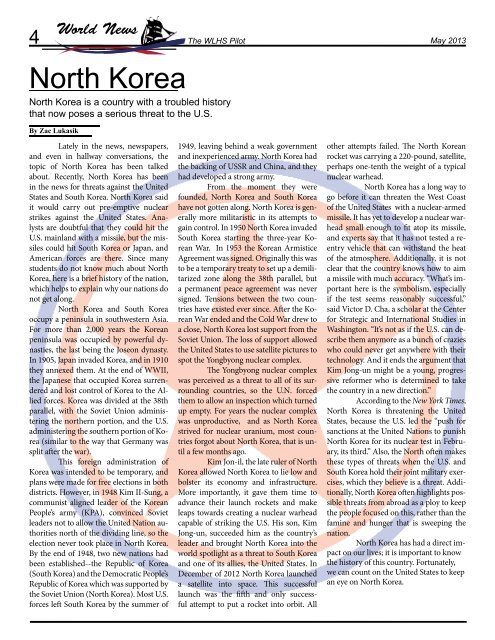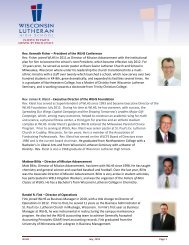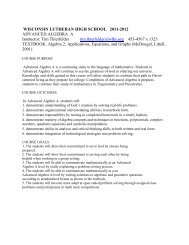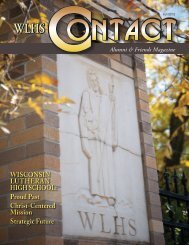Pilot - Wisconsin Lutheran High School
Pilot - Wisconsin Lutheran High School
Pilot - Wisconsin Lutheran High School
Create successful ePaper yourself
Turn your PDF publications into a flip-book with our unique Google optimized e-Paper software.
World News<br />
4 The WLHS <strong>Pilot</strong><br />
May 2013<br />
North Korea<br />
North Korea is a country with a troubled history<br />
that now poses a serious threat to the U.S.<br />
By Zac Lukasik<br />
Lately in the news, newspapers,<br />
and even in hallway conversations, the<br />
topic of North Korea has been talked<br />
about. Recently, North Korea has been<br />
in the news for threats against the United<br />
States and South Korea. North Korea said<br />
it would carry out pre-emptive nuclear<br />
strikes against the United States. Analysts<br />
are doubtful that they could hit the<br />
U.S. mainland with a missile, but the missiles<br />
could hit South Korea or Japan, and<br />
American forces are there. Since many<br />
students do not know much about North<br />
Korea, here is a brief history of the nation,<br />
which helps to explain why our nations do<br />
not get along.<br />
North Korea and South Korea<br />
occupy a peninsula in southwestern Asia.<br />
For more than 2,000 years the Korean<br />
peninsula was occupied by powerful dynasties,<br />
the last being the Joseon dynasty.<br />
In 1905, Japan invaded Korea, and in 1910<br />
they annexed them. At the end of WWII,<br />
the Japanese that occupied Korea surrendered<br />
and lost control of Korea to the Allied<br />
forces. Korea was divided at the 38th<br />
parallel, with the Soviet Union administering<br />
the northern portion, and the U.S.<br />
administering the southern portion of Korea<br />
(similar to the way that Germany was<br />
split after the war).<br />
This foreign administration of<br />
Korea was intended to be temporary, and<br />
plans were made for free elections in both<br />
districts. However, in 1948 Kim II-Sung, a<br />
communist aligned leader of the Korean<br />
People’s army (KPA), convinced Soviet<br />
leaders not to allow the United Nation authorities<br />
north of the dividing line, so the<br />
election never took place in North Korea.<br />
By the end of 1948, two new nations had<br />
been established--the Republic of Korea<br />
(South Korea) and the Democratic People’s<br />
Republic of Korea which was supported by<br />
the Soviet Union (North Korea). Most U.S.<br />
forces left South Korea by the summer of<br />
1949, leaving behind a weak government<br />
and inexperienced army. North Korea had<br />
the backing of USSR and China, and they<br />
had developed a strong army.<br />
From the moment they were<br />
founded, North Korea and South Korea<br />
have not gotten along. North Korea is generally<br />
more militaristic in its attempts to<br />
gain control. In 1950 North Korea invaded<br />
South Korea starting the three-year Korean<br />
War. In 1953 the Korean Armistice<br />
Agreement was signed. Originally this was<br />
to be a temporary treaty to set up a demilitarized<br />
zone along the 38th parallel, but<br />
a permanent peace agreement was never<br />
signed. Tensions between the two countries<br />
have existed ever since. After the Korean<br />
War ended and the Cold War drew to<br />
a close, North Korea lost support from the<br />
Soviet Union. The loss of support allowed<br />
the United States to use satellite pictures to<br />
spot the Yongbyong nuclear complex.<br />
The Yongbyong nuclear complex<br />
was perceived as a threat to all of its surrounding<br />
countries, so the U.N. forced<br />
them to allow an inspection which turned<br />
up empty. For years the nuclear complex<br />
was unproductive, and as North Korea<br />
strived for nuclear uranium, most countries<br />
forgot about North Korea, that is until<br />
a few months ago.<br />
Kim Jon-il, the late ruler of North<br />
Korea allowed North Korea to lie low and<br />
bolster its economy and infrastructure.<br />
More importantly, it gave them time to<br />
advance their launch rockets and make<br />
leaps towards creating a nuclear warhead<br />
capable of striking the U.S. His son, Kim<br />
Jong-un, succeeded him as the country’s<br />
leader and brought North Korea into the<br />
world spotlight as a threat to South Korea<br />
and one of its allies, the United States. In<br />
December of 2012 North Korea launched<br />
a satellite into space. This successful<br />
launch was the fifth and only successful<br />
attempt to put a rocket into orbit. All<br />
other attempts failed. The North Korean<br />
rocket was carrying a 220-pound, satellite,<br />
perhaps one-tenth the weight of a typical<br />
nuclear warhead.<br />
North Korea has a long way to<br />
go before it can threaten the West Coast<br />
of the United States with a nuclear-armed<br />
missile. It has yet to develop a nuclear warhead<br />
small enough to fit atop its missile,<br />
and experts say that it has not tested a reentry<br />
vehicle that can withstand the heat<br />
of the atmosphere. Additionally, it is not<br />
clear that the country knows how to aim<br />
a missile with much accuracy. “What’s important<br />
here is the symbolism, especially<br />
if the test seems reasonably successful,”<br />
said Victor D. Cha, a scholar at the Center<br />
for Strategic and International Studies in<br />
Washington. “It’s not as if the U.S. can describe<br />
them anymore as a bunch of crazies<br />
who could never get anywhere with their<br />
technology. And it ends the argument that<br />
Kim Jong-un might be a young, progressive<br />
reformer who is determined to take<br />
the country in a new direction.”<br />
According to the New York Times,<br />
North Korea is threatening the United<br />
States, because the U.S. led the “push for<br />
sanctions at the United Nations to punish<br />
North Korea for its nuclear test in February,<br />
its third.” Also, the North often makes<br />
these types of threats when the U.S. and<br />
South Korea hold their joint military exercises,<br />
which they believe is a threat. Additionally,<br />
North Korea often highlights possible<br />
threats from abroad as a ploy to keep<br />
the people focused on this, rather than the<br />
famine and hunger that is sweeping the<br />
nation.<br />
North Korea has had a direct impact<br />
on our lives; it is important to know<br />
the history of this country. Fortunately,<br />
we can count on the United States to keep<br />
an eye on North Korea.
















